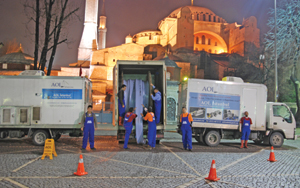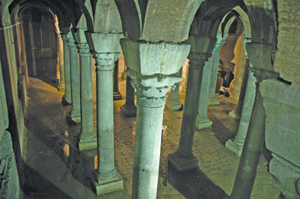History Preserved in Turkey
February 1, 2009
 From a Turkish perspective, the concept of aging sewer systems is relative. In Turkey, the basic concepts of modern sanitation, including indoor toilets and sewer pipe systems, date back to at least 764 BCE as evidenced in castles of the Urartu Kingdom. Almost 1,000 years later when Constantine founded Constantinople, the city was engineered with Roman cisterns and sewers thereby laying the foundation for one of the greatest cities of the world.
From a Turkish perspective, the concept of aging sewer systems is relative. In Turkey, the basic concepts of modern sanitation, including indoor toilets and sewer pipe systems, date back to at least 764 BCE as evidenced in castles of the Urartu Kingdom. Almost 1,000 years later when Constantine founded Constantinople, the city was engineered with Roman cisterns and sewers thereby laying the foundation for one of the greatest cities of the world. The sanitation systems of Constantinople enabled it to become the largest and wealthiest city of Europe throughout the Middle Ages. Today, Istanbul has become the third largest city in the world with a population of more than 11 million. Like any major global metropolis, Istanbul relies upon its sanitation infrastructure to permit such population concentrations.
With a focus on sustainability and cost control, the Istanbul Water and Sewer Department (ISKI) commenced a master plan in 1992 to direct Istanbul’s water and wastewater investment efforts through 2040. No matter how well engineered, when sewer systems age, eventually joints fail, pipes crack, roots intrude and systems must be rehabilitated or replaced to ensure continued service. However, when pipes are buried under centuries of dense urban development, access becomes more difficult than most engineers could even imagine. Such challenges are the norm in Istanbul. Whereas trenchless technology is routinely considered a valuable tool in most major cities of the world, trenchless pipe rehabilitation was recognized as absolutely invaluable to Istanbul.
The entirety of Old Town Istanbul is registered as a World Heritage Site. The very idea of tearing up centuries-old cobblestone streets seems blasphemous. Furthermore, the prospective economic impact of disrupting traffic and business operations in this center of tourism cannot be understated. ISKI was faced with tough choices and few solutions. It needed to stop the continuing degradation of its ancient sewer system, which was threatening the survival of numerous historical sites in addition to being a sanitation concern. But simultaneously, it absolutely couldn’t tear up the historical sites to fix the problems.
An excellent example of the kind of dilemma regularly faced by ISKI is the Binbirdirek Cistern, which was built in AD 330 as Constantinople was being founded. As centuries passed, the infrastructure above this 224-column cistern grew and changed. Today, restaurants and hotels line a cobblestone street above the cistern; inconveniently, the sewer pipe servicing this street began leaking and exfiltrating into the cistern below. To exhume and replace the old sewer line would close businesses, disrupt traffic in the heart of the historical tourism district and most probably destroy the cistern below. To do nothing would be to allow the continued decay and disuse of the cistern.
In searching the world for solutions to problems such as this, ISKI identified trenchless pipe lining as a viable solution and realized that such technologies needed to be routinely available in Turkey. Any country desiring entry into the European Union (EU) is required to meet infrastructure quality standards, and ISKI clearly understood that complying with those standards becomes more affordable with access to trenchless technology. Periodic access to such technology via international construction firms was not sufficient for its extensive needs. Rather than just accept the lack of local availability, ISKI began proactively developing a trenchless technology market in Turkey.
Turkish contractor Mehmet Kurtbay, P.E., MBA, saw not only a business opportunity in the pipe rehabilitation projects being released by ISKI, but also a means to serve the needs of his city and nation. Kurtbay began searching the world for technologies uniquely suited to the Turkish market. Whereas trenchless rehabilitation in Turkey was primarily only available through construction firms based in the EU, Kurtbay wanted to establish a Turkish pipe rehabilitation company. As a result, he established AOL Istanbul with his two partners on April 1, 2005.
Most pipelining technologies require extensive experience to avoid costly and disruptive failures. But the critical pipe rehabilitation projects in the historic peninsula of Istanbul absolutely could not afford any disruption caused by a contractor’s learning period. Exhumation simply was not and is not an option. Not surprising, few construction firms are interested in training their future competitors. As a result, Kurtbay wanted to find a technology that local labor could consistently perform with a minimum amount of training. He also wanted a technology where errors could be corrected at lower cost and with less disruption.
After extensively researching trenchless pipe rehabilitation technologies used around the world, Kurtbay believed Ultraliner PVC Alloy Pipeliner from Ultraliner Inc. of Oxford, Ala., was the technology solution. The big problem: At the time, it was only being used in North America and its advantages were not widely known or recognized in Europe.
Ultraliner president Luke Whittle explains, “At that time, we were not convinced that international expansion was a smart use of our resources. Ultraliner continues to grow rapidly across North America, routinely adding new licensees and crews to provide additional coverage. We believed that our resources should be focused upon continuing our successful domestic expansion.”
But Kurtbay and his partners were convinced that Turkey needed a product like Ultraliner PVC Alloy Pipeliner and they persisted. Ultraliner vice president Grant Whittle states, “He kept after us and wouldn’t relent. As we got to know Mehmet better, we were impressed with his business acumen and his engineering understanding. He is an exceptionally well-educated and savvy contractor. He has a civil engineering degree from the highly regarded Istanbul Technical University and also completed an MBA in the United States. His background makes it easy to work with him. Quite honestly, any concerns we initially had about the ability to support a licensee on the other side of the world were ultimately allayed by our confidence in Mehmet. As it turns out, that confidence has been well placed.”
 AOL Istanbul garnered enough confidence within ISKI that it awarded its first Ultraliner pipe rehabilitation project within the sensitive historic peninsula. Because Ultraliner PVC Alloy Pipeliner is shelf stable, a single bulk shipment was able to be exported from the United States to Turkey, thereby greatly simplifying project logistics. After AOL Istanbul acquired the requisite equipment, Ultraliner sent Sam McLean, its construction operations manager and most senior trainer, to Istanbul for 16 days. During the first week, McLean helped make final checks and adjustments to the installation equipment and oversaw aboveground field trials for preliminary training. The following week, he assisted the AOL Istanbul crews to install pipeliner for ISKI. The first three lines selected were in a less sensitive neighborhood where the capability of the AOL Istanbul crews could be assessed. These installations went so well, that with McLean’s oversight, the AOL Istanbul crews then lined two of the critical sewer lines above the Binbirdirek Cistern.
AOL Istanbul garnered enough confidence within ISKI that it awarded its first Ultraliner pipe rehabilitation project within the sensitive historic peninsula. Because Ultraliner PVC Alloy Pipeliner is shelf stable, a single bulk shipment was able to be exported from the United States to Turkey, thereby greatly simplifying project logistics. After AOL Istanbul acquired the requisite equipment, Ultraliner sent Sam McLean, its construction operations manager and most senior trainer, to Istanbul for 16 days. During the first week, McLean helped make final checks and adjustments to the installation equipment and oversaw aboveground field trials for preliminary training. The following week, he assisted the AOL Istanbul crews to install pipeliner for ISKI. The first three lines selected were in a less sensitive neighborhood where the capability of the AOL Istanbul crews could be assessed. These installations went so well, that with McLean’s oversight, the AOL Istanbul crews then lined two of the critical sewer lines above the Binbirdirek Cistern. The sewer pipes above the cistern were lined at night to prevent disrupting the nearby Magnaura historic site and the numerous hotels, restaurants, shops and tourist traffic. With the pipe ends accessible through the manholes, no excavation was required and no evidence was left of the project upon completion. The next morning, the cafés all placed their tables on the cobblestone streets above the lined sewer pipe and life went on without interruption.
Lining the pipes with Ultraliner PVC Alloy Pipeliner is expected to provide a renewed 100-year, fully structural performance life for the sewer pipes, while controlling root intrusion, infiltration and exfiltration. With the sewer exfiltration stopped by the ISKI pipe rehabilitation project, the historic Binbirdirek Cistern has subsequently been refurbished, currently houses a new restaurant and is open to the public for tours, as well as hosting exhibitions and concerts. A 1,700-year-old historic treasure has been preserved, and an exhibition featuring scale models of Istanbul’s Byzantine architecture is currently being hosted in the cistern.
After AOL Istanbul installed only five lines under his supervision, McLean returned to the United States and the local crews thereafter were able to prove their capabilities on their own. One of the key advantages of Ultraliner PVC Alloy Pipeliner is that it is a pre-manufactured pipe. All of the design properties that ensure specification compliance and ultimate performance life are factory quality-controlled and essentially unaffected by decisions of the crews during field installation. With fewer variables to influence a quality installation, less experience is required. Installation defects occurring after a crew has 20,000 lf of experience are rare. When mistakes or defects do occur, correction is relatively non-disruptive. If things go wrong, such as an equipment breakdown, the installation process can be stopped at any time and re-started as necessary. If a complete pipeliner installation failure ever occurs, the pipeliner can generally be removed without excavation. Such advantages make Ultraliner especially suited for use by local contractors in emerging pipe rehabilitation markets where experienced personnel are not available for hire.
Over the past three years, AOL Istanbul has lined close to 25 miles of sewer pipes in Istanbul, including the majority of sewer lines rehabilitated within Old Town. The company was recently awarded two additional projects by ISKI and currently operates three lining crews. Of particular note is the rehabilitation of sewer pipes around Hagia Sophia (one of the new seven Wonders of the Ancient World) and the equally impressive Sultan Ahmet Mosque.
Edited by Trenchless Technology, this article was submitted by Ultraliner, Oxford, Ala.
